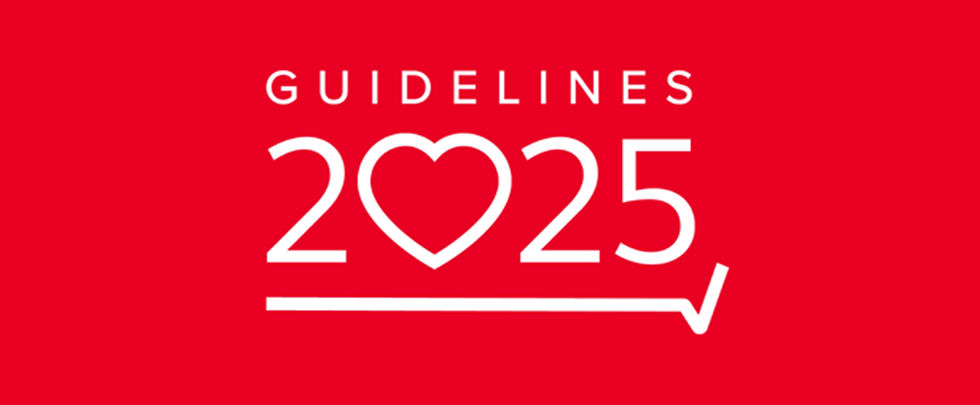Resuscitation Council UK 2025 Guidelines Released: What’s New and Why It Matters
- Slanjava Learning Ltd.

- Oct 27
- 4 min read
The Resuscitation Council UK (RCUK) has today released the 2025 Resuscitation Guidelines, marking a major update to national resuscitation practice since the last revision in 2021. Developed in collaboration with the European Resuscitation Council (ERC) and the International Liaison Committee on Resuscitation (ILCOR), the new guidance reflects the latest international evidence and best practice in emergency care.
Why the Update Matters
Every five years, the RCUK reviews and updates its guidelines to ensure lifesaving interventions remain evidence-based and consistent across education, healthcare, and community settings. The 2025 Guidelines will be implemented in training courses from January 2026, and represent a step forward in accessibility, technology use, inclusivity, and survivor support.
Key Updates in the Resuscitation Council UK 2025 Guidelines
1. Education and Training
Resuscitation education now starts earlier, from ages 4 to 6, with annual refreshers in schools.
Training must be inclusive and community-focused, using gamified learning, AI, augmented reality, and Rapid Cycle Deliberate Practice.
Telephone-assisted CPR becomes a national standard for ambulance call handlers.
Faculty must receive structured development in teaching and debriefing.
Education now embeds ethical decision-making and team communication skills.
2. Adult Basic and Advanced Life Support
Call 999 before assessing breathing if a person is unresponsive.
Reinforcement that anyone can perform CPR and use an AED, with compression-only CPR suitable for untrained rescuers.
Compression rate and depth remain at 100–120 per minute and 5–6 cm, with minimal interruptions.
Call handlers play an expanded role in CPR guidance and AED location linkage via The Circuit network.
Adrenaline remains standard in non-shockable rhythms (early) and after the third shock in shockable rhythms.
Extracorporeal CPR (ECPR) is now recommended for certain refractory cases in specialist centres.
3. Post-Resuscitation Care
Emphasis on structured, ABC-based management after Return of Spontaneous Circulation (ROSC).
Temperature management: maintain ≤37.5°C for 36–72 hours.
Seizures: treat with levetiracetam or sodium valproate; neuroprotective drugs are not routinely used.
Prognostication: delay decisions on withdrawal of care until at least 72 hours post-ROSC, using multimodal assessment (EEG, biomarkers, imaging).
Introduces structured follow-up within three months and ongoing rehabilitation for survivors and families.
4. Paediatric and Newborn Life Support
Stronger focus on early recognition of critical illness and structured ABCDE assessments.
Extracorporeal CPR highlighted for selected children.
New chapter on special circumstances, including trauma, asthma, drowning, and hypothermia.
For newborns:
Reduced emphasis on skin colour due to unreliability across skin tones.
Focus instead on heart rate, breathing, tone, and response to stimulation.
Sodium bicarbonate is no longer recommended.
Clear guidance for home and out-of-hospital births, including telemedicine support.
5. First Aid: A New Chapter
For the first time, first aid has its own dedicated section in the Guidelines.
Defines first aid as “help provided by anyone, in any situation.”
Covers:
Scene safety, early 999 calls, reassurance, and structured ABCDE assessment.
Life-threatening emergencies such as bleeding, choking, asthma, anaphylaxis, hypoglycaemia, overdose, and stroke.
Environmental emergencies such as heat stroke, hypothermia, snake bite, and concussion.
Encourages inclusive, community-level training and psychological support for rescuers after witnessing emergencies.
6. Ethics and Systems Saving Lives
Promotes early, person-centred discussions using ReSPECT forms, ensuring decisions are recorded and shared across care settings.
Families should be supported and offered the choice to be present during resuscitation.
Organisations must have clear policies, training, and audit mechanisms for ethical decision-making.
Systems Saving Lives introduces:
Mandatory CPR training for schoolchildren, students, and drivers.
Strengthened first responder systems linked to AED registries.
Improved post-arrest survivorship care and involvement of survivors in research and policy design.
What This Means for Training Providers and Workplaces
For organisations delivering First Aid, AED, or Basic Life Support training, the 2025 Guidelines mark a shift toward:
Earlier education and continuous refreshers.
Technology-enhanced learning methods.
A holistic focus on emotional support, ethics, and community readiness.
Slanjava Learning Ltd will ensure that all First Aid and CPR courses reflect these changes in line with RCUK implementation from January 2026. Updated course content, teaching aids, and learner resources will be available ahead of rollout.
Book Your Updated First Aid Training
Ensure your team’s knowledge and practice are aligned with the new Resuscitation Council UK 2025 Guidelines.
Our accredited Emergency First Aid, First Aid at Work, and CPR & AED courses will be fully updated to reflect the latest evidence and best practice from January 2026.
Contact us to discuss in-house or group training options across Scotland and the UK:
Email: info@slanjavalearning.co.uk
Visit: www.slanjavalearning.co.uk
Kind regards,
Slanjava Learning Ltd | Helping others to help others
Award-winning Health & Social Care Training
-slàinte mhath-
References and Further Reading
Resuscitation Council UK (2025). Resuscitation Guidelines 2025. Available at: https://www.resus.org.uk/professional-library/2025-resuscitation-guidelines
Perkins, G. and Benson Clarke, A. (2025). Executive Summary of the Main Changes Since the 2021 Guidelines. Resuscitation Council UK.
European Resuscitation Council (2025). ERC Guidelines 2025. Available at: https://cprguidelines.eu
ILCOR (2025). Consensus on Science and Treatment Recommendations (CoSTR). Available at: https://costr.ilcor.org












Comments